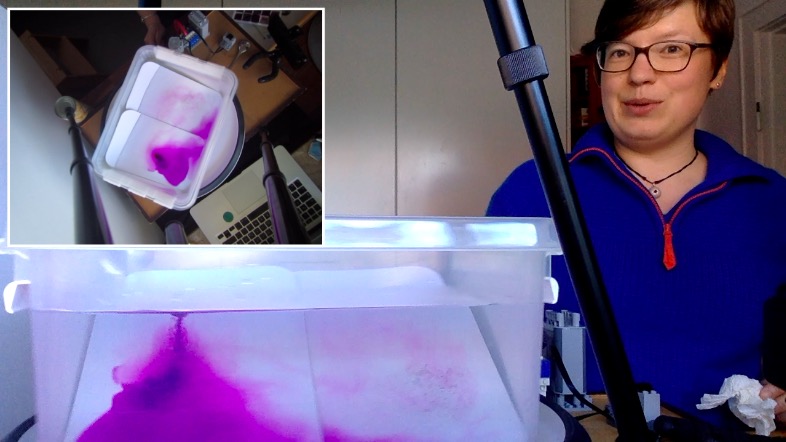
Rossby-#WaveWatchingWednesday
Several of my friends were planning on teaching with DIYnamics rotating tables right now. Unfortunately, that’s currently impossible. Fortunately, though, I have one at home and enjoy playing with it enough that I’m
- Playing with it
- Making videos of me playing with it
- Putting the videos on the internet
- Going to do video calls with my friends’ classes, so that the students can at least “remote control” the hands-on experiments they were supposed to be doing themselves.
Here is me introducing the setup:
Today, I want to share a video I filmed on planetary Rossby waves. To be clear: This is not a polished, stand-alone teaching video. It’s me rambling while playing. It’s supposed to give students an initial idea of an experiment we’ll be doing together during a video call, and that they’ll be discussing in much more depth in class. It’s also meant to prepare them for more “polished” videos, which are sometimes so polished that it’s hard to actually see what’s going on. If everything looks too perfect it almost looks artificial, know what I mean? Anyway, this is as authentic as it gets, me playing in my kitchen. Welcome! :-)
In the video, I am using an ice cube, melting on a sloping bottom in a rotating tank, to create planetary Rossby waves. Follow along with the whole process:
Also check out the video below that shows both a top- and side view of a planetary Rossby wave, both filmed with co-rotating cameras.
Previous blog posts with more movies for example here.
Now. What are you curious about? What would you like to try? What would you do differently? Any questions for me? :-)
Jan says:
Thanks a lot for your nice blog Mirjam ;)
I wonder what happens if only the Coriolis force on the surface of our spinning planet is simulated in the tank. Would the downwelling of anticyclonic eddies be visible in your tank? I mean without the density difference of the ice? For example, a piece of sponge with potassium permanganate?
But what i really would be interested in would be highly stratified layers and wind forcing and which kind of turbulence’s created by different kinds of wind – constant wind blowing horizontal – from a above – high frequency winds with impulses etc. – to see which kind of winds create turbulence’s that cross the thermocline and would mix heat to greater depths… Further, i really would like to see how mixed layer depth influences turbulence’s or eddies and vertical mixing of a stratified or weakly/non stratified water column and water transport across the thermocline.
All the best
Jan
p.s. and sorry for the sloppy writing, just trying to understand turbulence’s and vertical mixing in the oceans – tough subject thou, to come to grasph’s with ;)
Mirjam says:
Hi Jan,
Wow, thanks for all the inspiring questions!
If we just simulated the influence of Coriolis force on the ocean, we’d end up with basically a bucket of water in solid body rotation. In order to generate the eddies, we need to introduce some kind of disturbance to the system. Either with ice, or for example by stirring. What we can see (not very obviously, but rather by carefully positioning ourselves such that we see reflections of e.g. lights on the surface of the tank) is that the surface is being deformed by eddies. I think the potassium permanganate would probably obstruct what we are trying to see, because it would be sinking by itself due to its different density, thus making it seem like there is downwelling due to eddies going on when it’s just sinking due to higher density. I have yet to come across tracers that would act as really passive tracers and would really show vertical movement of water without influencing it themselves.
I’ve tried mixing with wind (e.g. here: https://mirjamglessmer.com/2018/08/01/experiment-influence-of-stratification-on-mixing/) but I haven’t gotten very far. In the ocean, we have space enough for a fetch that goes over many many kilometers, I haven’t come up with a good way to simulate that in a tank and always end up creating new problems when I manage to fix one. What kind of setup were you thinking of?
Best wishes, Mirjam